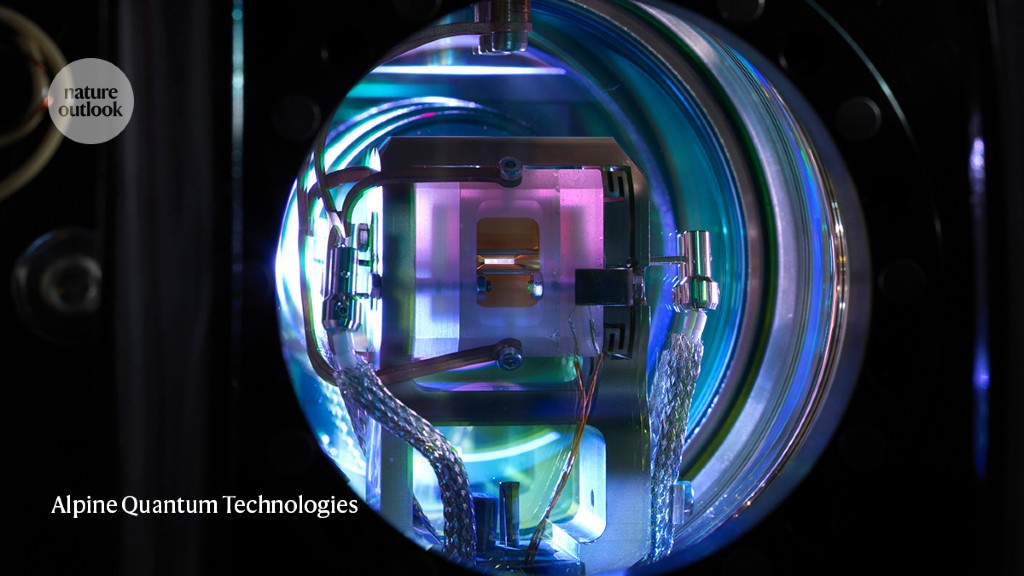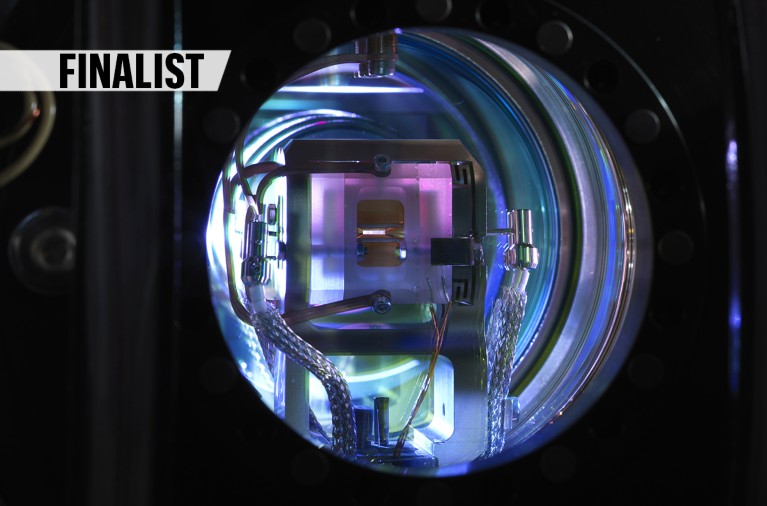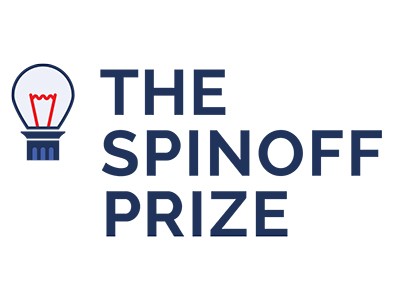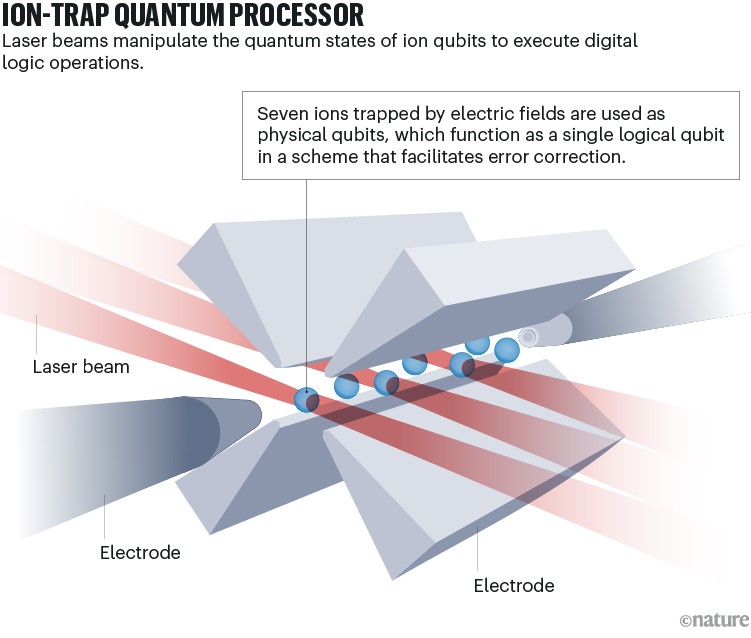Alpine Quantum’s ion trap acts as a quantum processor.Credit: Alpine Quantum Technologies
Alpine Quantum Technologies in Innsbruck, Austria, spun off from the University of Innsbruck and the Austrian Academy of Sciences, Vienna, in 2018.
Quantum computers promise to outstrip their conventional counterparts in a range of demanding tasks by harnessing certain strange properties of the atomic world. Whether the challenge is designing new materials, optimizing delivery logistics or developing drugs, these machines should, in principle, be able to perform calculations much faster than classical devices.
Read more about The Spinoff Prize
Alpine Quantum Technologies (AQT), a start-up in Innsbruck, Austria, that spun off from the University of Innsbruck and the Austrian Academy of Sciences in Vienna, is building computers that have the potential to do all of this and more. Those computers are based on ion traps, which consist of arrays of single ions held in a vacuum by electrical fields and manipulated by extremely short laser pulses. AQT’s take on this technology is among the most advanced in the world. But the company’s scientists are clear that realizing a fully-fledged quantum computer will not be easy.
Unlike some rival companies, which are attempting to offer a combination of hardware, software and applications, AQT focuses solely on hardware. It sells individual components — such as ion traps, laser stabilizers and the associated electronics — to other researchers investigating quantum phenomena, while also developing its own ion-trap quantum computers. (Another finalist in The Spinoff Prize 2023, Parity Quantum Computing, by contrast, sells blueprints for quantum computers that can be applied to any type of hardware, not just ion traps.)
Strange and delicate
Quantum computers derive their unique capabilities from counter-intuitive phenomena. Whereas units of data called bits in a standard digital device take on the values of either 0 or 1, quantum bits — or qubits — can exist in what is known as a superposition of 0 and 1 at the same time. What’s more, multiple qubits can be entangled such that their states are interdependent in a way that is not possible with everyday classical objects — those larger than a few atoms. Taken together, superposition and entanglement enable a set of qubits to exist in all possible combinations of 0s and 1s simultaneously, which yields a potentially huge processing-speed advantage over current classical computers.
But with great power comes great fragility. Quantum states can be destroyed by even the tiniest disturbance, including minuscule amounts of heat or radio-wave energy. So although qubits must be manipulated to execute quantum algorithms, they must also remain as isolated as possible from the outside world.
Part of Nature Outlook: The Spinoff Prize 2023
Physicists are trying to satisfy these conflicting objectives by investigating qubits made from a variety of quantum systems, including electrical currents in superconducting circuits, the magnetic spin of electrons or atomic nuclei embedded in crystalline solids, and photons travelling around silicon circuits. Each type of qubit has its pros and cons. The main advantage of ion traps is that they are relatively insusceptible to noise. Their drawback is the bulky equipment needed, including lasers and associated electronics.
Still, no type of qubit can remain immune to noise as quantum computers are scaled up, says Thomas Monz, a quantum physicist at the University of Innsbruck, and co-founder and chief executive of AQT. Increasing the number of qubits, along with the number of processor operations (known as gates), makes it more likely that mistakes will creep in during calculations. The solution to this is error correction, which involves using multiple physical qubits to represent a single logical bit of data. That way, the value of those qubits can be compared, and the system can weed out any that succumb to noise.
But error correction does not come cheap. Typically, it multiplies the number of qubits required for any given calculation by several orders of magnitude, meaning, Monz says, that at least one million qubits are likely to be needed to rival classical computers. That’s a long way from the few dozen that are typical of the most-advanced quantum computers.
Slowly does it
AQT emerged from nearly one-quarter of a century of research on ion-trap quantum computing carried out at the University of Innsbruck by physicists Peter Zoller and Rainer Blatt, and, later, Monz. As Monz recalls, researchers at other institutions would often approach the group to ask if they could buy ion traps and associated accessories. Wanting to help but realizing, as Monz puts it, that he couldn’t use Austrian taxpayers’ money to satisfy the requests, he set about preparing a financial plan. In 2018, the trio set up AQT to sell the sought-after components while ultimately aiming to build a full-scale computer of their own.
For Lieven Vandersypen, who is developing rival ‘quantum dot’ qubits at Delft University of Technology in the Netherlands, this dual approach makes sense. Selling the components “generates some income and puts them in a commercial operating mode”, he says, while allowing the researchers to work on the “long-term challenges of a large-scale quantum-computing system”.
That long-term work is bearing fruit. In 2020, Monz, Blatt and their colleagues reported how to fix one previously uncorrected type of error that can plague quantum calculations — the loss of a qubit in a ‘register’1. They followed this up by demonstrating a complete set of gates that could be used to process qubits in a universal quantum computer2. This device is capable of any kind of computation, whether quantum or classical. They did so by entangling two error-corrected logical qubits, the values of which were each distributed over seven ions (see ‘Ion-trap quantum processor’).
Credit: Alisdair MacDonald
Despite this encouraging progress, the AQT team is determined to keep expectations in check. The company has successfully demonstrated several universal quantum computers, installed in industry-standard 19-inch racks, used for computer servers. Monz acknowledges that manufacturers of quantum computers often boast about the quantity of qubits in their processors — the US technology giant IBM, for example, has announced plans for a computer with around 1,000 superconducting qubits this year. But Monz does not want to join in the numbers game. What really matters, he contends, is the quality of the qubits. “If you want to make schnapps, it doesn’t make any difference whether you have 10 or 100 rotten apples,” he says. “You need to start with 10 good apples.”
The current version of AQT’s computer comes in two forms: a system that has two error-corrected high-quality qubits, or a system with ten times that number of lower-quality ones. Monz reckons that most customers will opt for the latter, which he says could still be suitable for tasks for which errors are not very problematic, such as optimizing financial portfolios or investigating logistics problems. “There will be this transition where everyone initially will work with faulty qubits and find use cases,” he says. “Only later, when the community has access to abundant error-corrected qubits, will we be able to achieve ultra-high-precision quantum computing.”
AQT has 20 employees and generated around €1 million (US$1.1 million) in sales in 2021, having sold its ion-trap components to academic and industrial research groups in Europe, North America and Asia. It also offers access to its quantum computers either remotely through the cloud or by installing them in customers’ labs. So far, however, it has not sold any complete working systems.
AQT’s technology director, Juris Ulmanis, explains that he and his colleagues are mindful of not over-promising, ensuring that the quantum bits and gates that make up their processors are as robust as possible before the devices are scaled up. “You need to excite people and inspire them, but at the same time stay realistic about what is possible,” Ulmanis says.
Such cautious assessments come from outside the company as well. Vandersypen, for example, points out that AQT’s strategy might have a flaw: selling its components could give competitors a heads-up on the inner workings of the firm’s technology.
Monz acknowledges this concern, explaining that he and his colleagues do not sell everything they produce. Indeed, they keep at least some of their secret ingredients off the shelves. “There is still quite a bit of ‘special sauce’ left,” he says.











More News
Author Correction: Stepwise activation of a metabotropic glutamate receptor – Nature
Changing rainforest to plantations shifts tropical food webs
Streamlined skull helps foxes take a nosedive